!!! My website has
moved: please update your bookmarks to debunix.net !!!
Grindal
Worms
I love the grindals because they like normal room
temperatures, unlike white worms that need it cool (I hate the idea of
running even a small refrigerator just to keep it cool for the worms to
feed the fish). I
grow them in small plastic boxes, as shallow as I can get (you're
really growing them only on the top surface, so deeper boxes just take
up more
room without providing more worms). I have a small rack
(purchased with some little "drawers" from an office supply store,
drawers discarded, that allows me to stack several in a small space)
that holds several of them under the sink (they prefer the dark), and
can stack more on top as
needed, giving me enough growing surface to produce more grindals than
all my fish can eat.
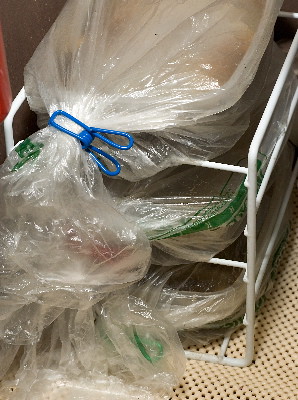
Each box is filled with half an inch to an inch of Magic Worm Bedding (Magic Products Inc),
kept quite moist. I use this bedding for my worm compost bin,
because it seems to keep the redworms happier, so I always have it on
hand. Other people use various soil or peat mixes, or go dirtless
with sponges or green plastic scrubbies. I trim the lids of the
boxes off on two sides
so they fit inset into the box, on top of the worms and their food, but
cover most of the box. The more of the surface you cover with the
lid, the more of it you can actively use for harvest. The edges
of the lid that remain provide a convenient handle, and the plastic lid is
easier and safer than the piece of glass that is often recommended:

The boxes are loosely wrapped in a plastic bag to keep out fruit flies

Each evening I take off the lid,
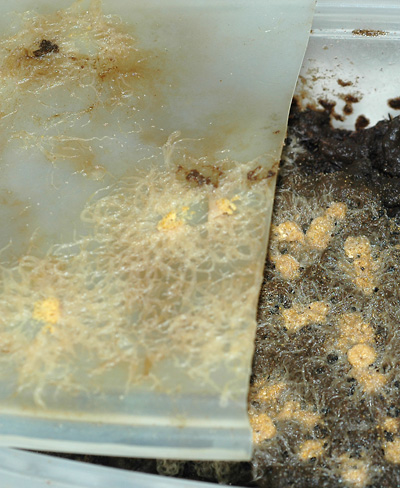
return any visible pellets of catfood (like this in the middle of this
closeup) to the box

and wipe the worms off into a dish of tap water:
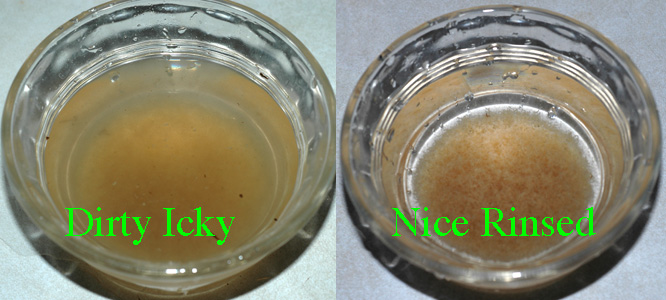
The worms are swirled around and allowed to settle, the water poured
off, and new water added, and rinsed this way several times while I'm
also thawing the frozen food and preparing the brine shrimp and
microworms. By the time I'm done they are much cleaner and ready
to be dropped into the tank from my miniature baster. The box of
worms gets a few fresh pellets of cat kibble. I started with
Science Diet
feline
maintainance light, since that's what I fed to the cat, but I have
recently learned that kitten food may be better because it has more
vitamin C that will eventually get passed through to the fish.
However, the Science Diet kitten food molded too easily, and the worms
did not seem to swarm over it as readily, so I have switched to Purina Kitten Chow, which seems to work a little better.
Here is the fed culture ready to be covered, wrapped, and put away:
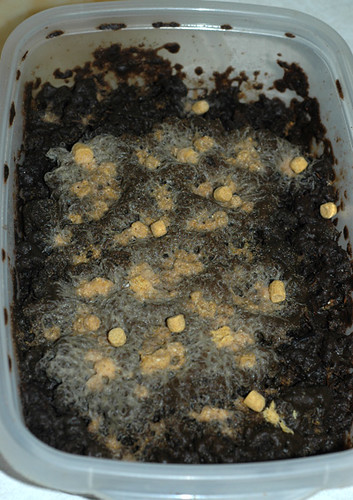
Alternative foods for grindals include trout chow, other
fish food, baby cereal, or soaked slices of bread: they're really
not very picky. But the kibble is clean, easy to use, keeps them
up on the surface for easy harvest, and resists mold better than baby
cereal.
All my fish love grindals, and I love getting a couple of tablespoons
of live
food daily from a bit of cat
food and a
small investment in
space.
And I have not had to restart the cultures very often--they've gone
about a year between restarts; if I add too much food and
some molds (rare but it does happen), I remove the moldy bit and the
culture goes on; if it gets
a little too wet, a few days with the bag loosened dries it out a bit;
if
I leave on vacation I just let them go in their bags until I get back
(refrigeration was a bad idea: the worms died and it was
nasty).
I recently discovered what seems to be a really good way to start new
cultures: I take the cleaned, rinsed worms when I have some
extra, pull them up in the baster, and let them sit in the baster until
they sink into a sludge about to fall out of the tip.

I put a few
drops of this concentrated mass of worms over a fresh piece of kibble
in a new container of fresh, damp, worm bedding. There is a good
ratio of worm to food right away, so the culture starts without a lot
of moldy kibble or hungry worms trying to find their way to the new
food.
Plastic shoeboxes are also popular to keep grindals, but beware that
loose-fitting lids
invite fruit flies. Another unwelcome visitor to grindal
and white worm cultures are springtails, tiny little bugs that look
like little white specks on the surface of the culture media.
When they invaded my white worms (possibly coming from a bag of
poor-quality peat I used for the bedding mix), they quickly took it
over, despite attempts to flood and freeze the culture to kill them off
(but spare the worms). With the grindals, I found that they
seemed to outcompete the springtails, without any special
treatment. I saw a few springtails, then a few more, then they
gradually disappeared over a few weeks.
Grindals on scrubber pads
After an outbreak of mites in my grindals, which recurred after I
subcultured them very carefully trying to avoid carrying along any
worms, I tried some "soiless" cultures on green scrubber pads.
These are now going great guns and the mites have not entirely
vanished, but are remaining at a low, manageable level. I also
switched from using plastic bags to an old pillow case to seal out the
fruit flies, which also is working quite well. These
cultures are much slower to get established, and respond to
overfeeding with impressively nasty molds if you're too
enthusiastic--daily feedings are best, just enough for the worms to eat
within 24 hours.
Here is the stack o'cultures in the pillowcase:
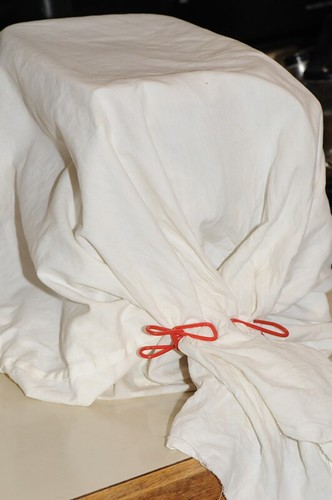
And what it looks like inside:

Baring the worms:
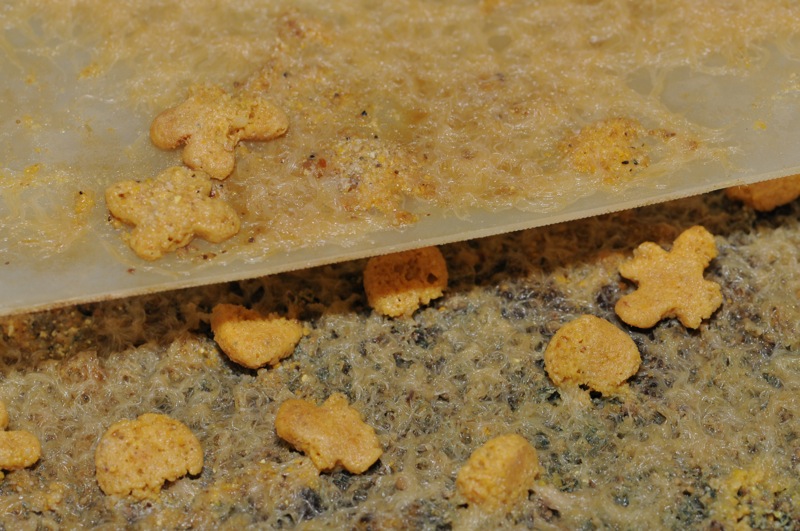
And this is what the culture looks about 8 hours after feeding:
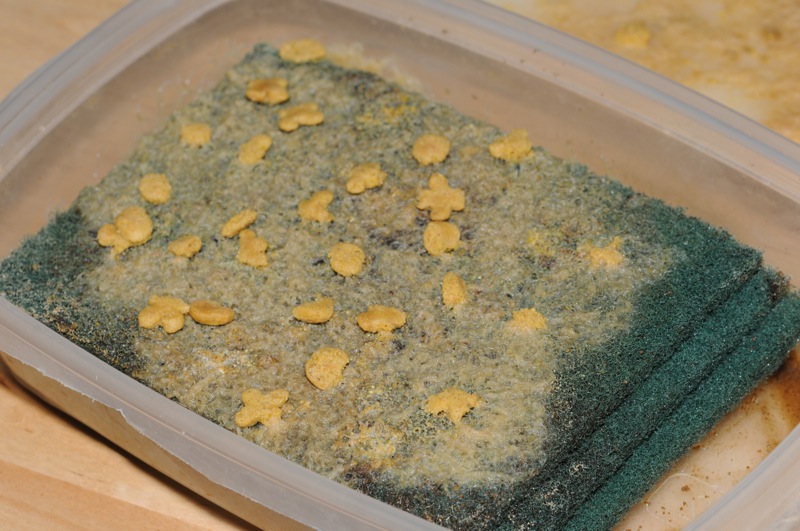
And the worms on the lid are ready for harvesting with a swipe of the finger:
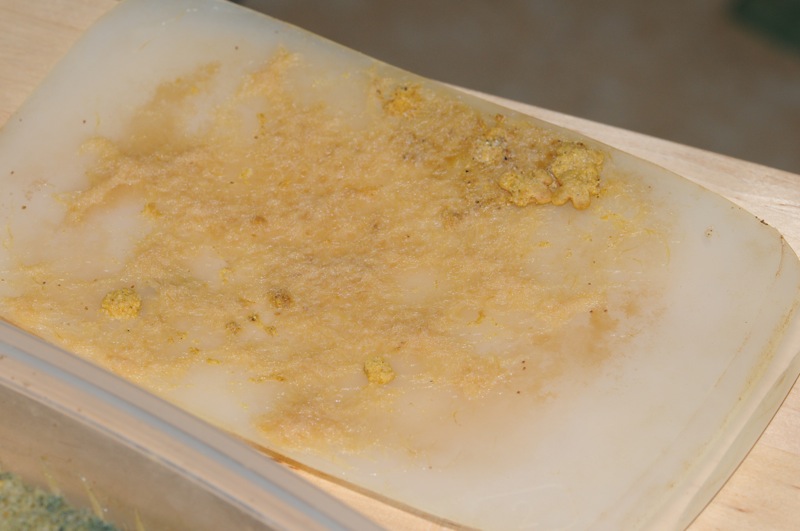
The goop at the bottom may be where there are freshly hatched worms, so maybe it shouldn't be thrown out:
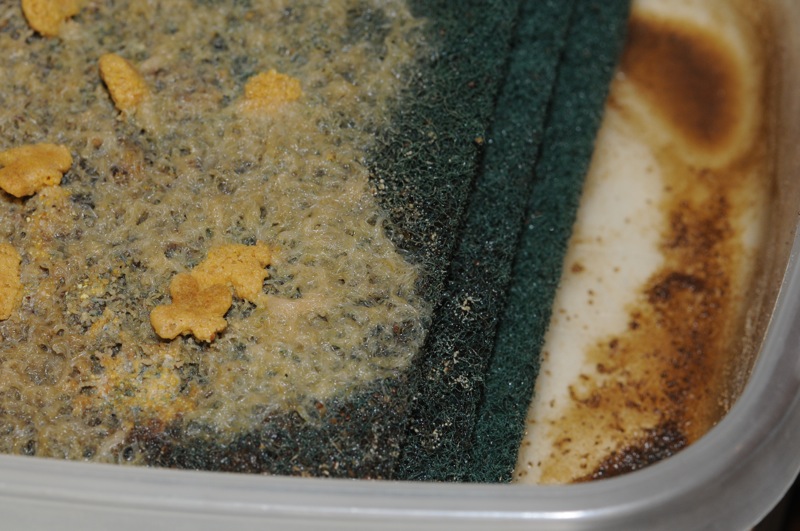
And you can make a little more of that by periodically rinsing the culture pad with a little tap water (not dechlorinated).
This is the dense, well-established culture:
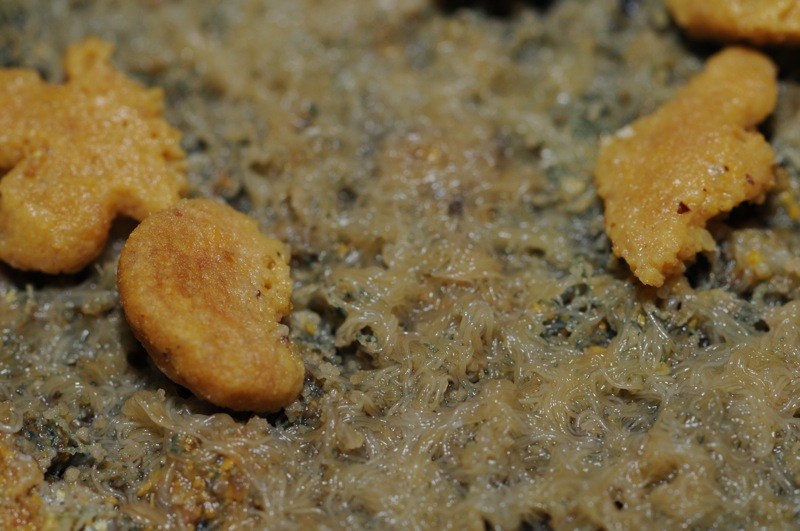
And this is a new culture, only about 2-3 weeks old, given new blobs of
worms and dampened kibble, little by little, only feeding as much as it
will eat overnight. It takes many weeks to build up to a
well-established culture like the one above.

I have not been raising them on the pads for that long--about 18
months now--and don't have clear criteria for splitting or renewing
cultures. Gradually increasing the number of kibbles fed
daily--again, only as much as the worms will eat--is a very slow but
safe way to get them to the size and productivity of the very well
established culture shown above.
I think I got much
faster establishment recently by a different technique, and I will try
this again in the future. The cultures are generally 3-5 pads
thick, and when my best-established culture got overwatered, and
started to smell of decaying worms, I removed a couple of the middle
pads, rinsed them under the tap (gently, trying to remove some of the
foul smelling muck but not let all the enmeshed worms escape), and
switched it out with a clean pad from the just-started cultures.
All three cultures did well after this.
Overwatering is a
problem with these cultures, as is drying out on hot dry days. I
generally add a little water to the bottom of the cultures daily after
I harvest and feed them--just enough to keep the bottom quite wet and
have a little water that will puddle if I tip the culture on end a bit,
but not enough to immerse the entire bottom of the culture box in
water. If they do get overwatered and a little moldy, pour
out some of the excess from the bottom of the box. Feed very
sparingly, and give them time to come back. They have come back amazingly well if I give them time.
White
Worms
I gave up on these because my apartment was too warm for them
(temps easily to 80 degrees in the summer even under the sink),
and I could keep them going but never really thriving, whether I used
synthetic sponges or dirt with ice packs in a cooler (and then I
discovered grindals, which do thrive here). Many people who keep
them have cool basements or use a refrigerator or wine cooler set to
about 55 degrees F. Another alternative I just learned about from
Jack Heller is to cut off the lower half of a 2 liter plastic soda
bottle, fill it with water, and freeze it. That block of ice, if
placed in a standard styrofoam fish box, in the middle of a few inches
of worm bedding, will take 2 days to thaw, at which point it can be
replaced with a freshly frozen block of ice. It gets too cold
right next to the ice for the worms, so they hang out a few inches away
from the ice block. They're otherwise cultivated just like
grindals, although some people grow these up on a much larger
scale. Some images of Charles' Harrison's white worms are here.
They are reputed to be fattening, so are not recommended
as a daily dietary staple.
Return to Live Food Cultures Overview
Return to My Fishroom
Back to Fish Page
Return to Diane's Home Page















